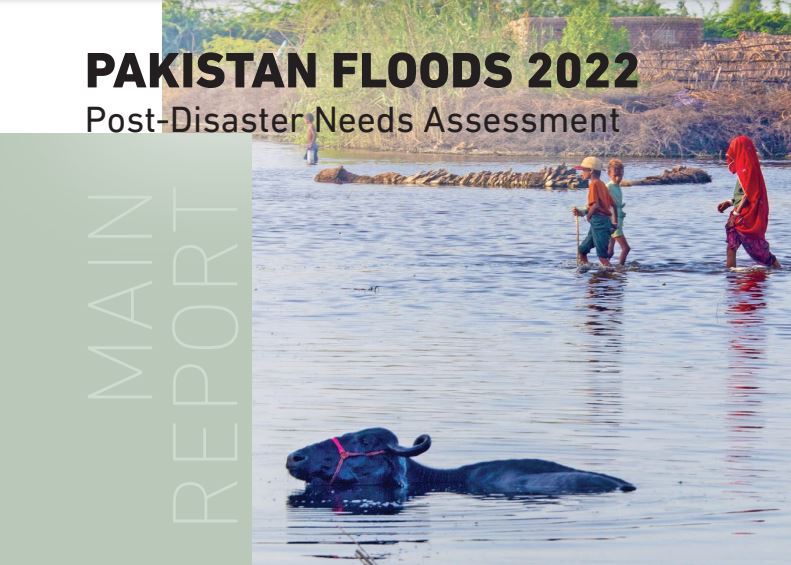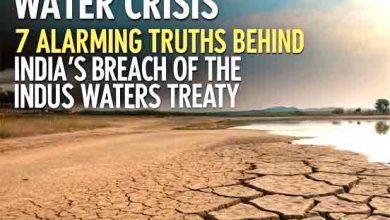Pakistan Needs US$16bn for Post-Flood Reconstruction as Losses Up to US $30bn
Pakistan’s needs more support for adaptation to #ClimateChange and overall resilience of the country to future #ClimateShocks.
- The total damage is estimated at PKR 3.2 trillion (US$14.9 billion), total loss at PKR 3.3 trillion (US$15.2 billion), and total needs at PKR 3.5 trillion (US$16.3 billion).
- The sectors that suffered the most damage are housing at PKR 1.2 trillion (US$5.6 billion); agriculture, food, livestock, and fisheries at PKR 800 billion (US$3.7 billion); and transport and communications at PKR 701 billion (US$3.3 billion).
- The transport and communications sector has the highest reconstruction and recovery needs at PKR 1.1 trillion (US$5.0 billion); followed by agriculture, food, livestock, and fisheries at PKR 854 billion (US$4.0 billion), and housing at PKR 592 billion (US$2.8 billion).
- The provinces of Sindh and Balochistan account for approximately 50 percent and 15 percent of recovery and reconstruction needs, respectively.
- Minister of Planning Development requests IMF to review conditions on development funds
- *These losses do not included investments required for Pakistan’s adaptation to #ClimateChange and overall resilience of the country to future #ClimateShocks.
ISLAMABAD: Final estimates regarding the damage from Pakistan’s recent disastrous floods are set be more than $30 billion, according to the planning ministry’s Post-Disaster Needs Assessment (PDNA) report that says the reconstruction works will need are over $16 billion.

PDNA Report states current Pakistan flood losses do not included investments required for Pakistan’s adaptation to climate change and overall resilience of the country to future climate shocks.
#ClimateChange induced disastrous #FloodsInPakistan
Between June and August 2022, torrential rains and a combination of riverine, urban, and flash flooding caused by historic monsoon rains have washed away roads, crops, infrastructure and bridges, killing over 1,000 people and affecting more than 33 million, over 15% of the country’s 220 million population.
The PDNA report, launched by the Minister of Planning Development and Special Initiatives Ahsan Iqbal accompanied by the Federal Minister for Climate Change Senator Sherry Rehman, was conducted jointly with the Asian Development Bank (ADB), the European Union (EU), the United Nations agencies with technical facilitation by the United Nations Development Programme (UNDP), and the World Bank.

According to the report, damage, loss, and needs assessment following the unprecedented floods in Pakistan calls for ‘building back better, based on the principles of the poor first, transparency, inclusion, and climate resilience
The assessment estimates total damages to exceed $14.9 billion (Rs3.2 trillion), and total economic losses to reach about $15.2 billion (Rs3.3 trillion).
Estimated needs for rehabilitation and reconstruction in a resilient way are at least $16.3 billion ($Rs3.5 trillion), not including much-needed new investments beyond the affected assets, to support Pakistan’s adaptation to climate change and overall resilience of the country to future climate shocks.
Speaking on the occasion, Iqbal highlighted the important pillars of the post-disaster recovery which include:
- Build Back Better
- People-Centred Socio-Economic Recovery
- Building systemic resilience against natural hazards and climate change impacts
Sector-wise needs
According to the report, the following sectors suffered the most significant damage these include:
- Housing — $5.6 billion (Rs1.2 trillion)
- Agriculture, food, livestock — $3.7 billion (Rs800 billion)
- Transport and communications — $3.3 billion (Rs701 billion)
The transport and communications sector has the highest reconstruction and recovery needs at Rs1.1 trillion ($5.0 billion); followed by agriculture, food, livestock, and fisheries at Rs854 billion ($4.0 billion), and housing at Rs592 billion ($2.8 billion).
Province-wise losses
It was also learnt that Sindh is the worst affected province with close to 70% of total damages and losses, followed by Balochistan, Khyber Pakhtunkhwa, and Punjab.
The provinces of Sindh and Balochistan account for approximately 50% and 15% of recovery and reconstruction needs.
Pakistan urges IMF to review conditions
Iqbal also requested the International Monetary Fund (IMF) allow Pakistan for utilising its development funds for disaster recovery, particularly the condition of spending at least 40% of Public Sector Development Programmes (PSDP) only in the last quarter of the financial year unwarranted under the current circumstances, and it must be revised, the minister said urging the IMF to review it.
Impact on economy
Extensive damage in agriculture, industry, and service sectors, estimated to be equivalent to 4.8% of FY22 gross domestic product (GDP at market prices at current prices for FY22 Rs66.9tr)
- Significant losses in GDP as a direct impact of the floods are projected to be around 2.2% in FY22 (nominal GDP at market prices for FY22 Rs66.9tr)
- Agriculture accounts for the largest decline at 0.9%
- Unprecedented recovery and reconstruction need to be projected at 1.6 times the budgeted national development expenditure for FY23
- Widening effect on primary and overall fiscal deficits
- Rising prices of food and essential items
- Higher poverty rates, with the national poverty rate estimated to increase by 3.7 to 4.0 percentage points, pushing between 8.4 and 9.1 million people into poverty
- The report highlighted that as recovery and reconstruction spending rise moving forward, the loss in output could be mitigated.
- Pakistan needs significant international support to complement its own commitment to increase domestic revenue mobilisation and save scarce public resources, and reduce the risk of exacerbating macroeconomic imbalances.
Although the early loss and damage estimates may increase as the situation continuously evolves on the ground, the PDNA laid the groundwork for a plan for recovery and reconstruction designed to build back a better future for the most affected people in Pakistan.
By M.A
#Water, #ClimateChange,#ClimateJustice,#Pakistan







